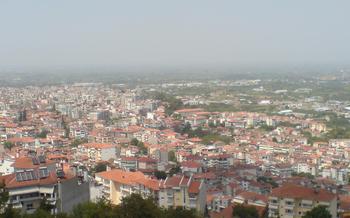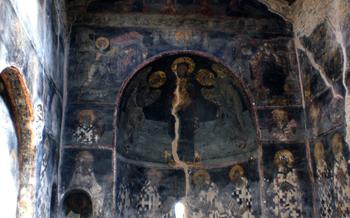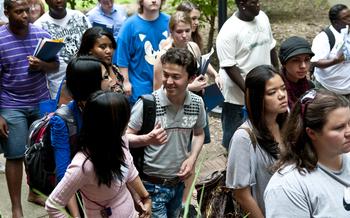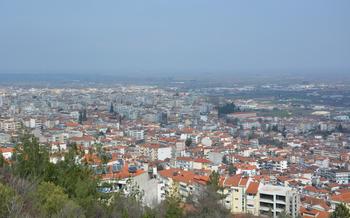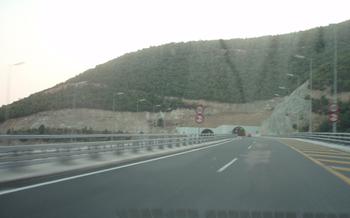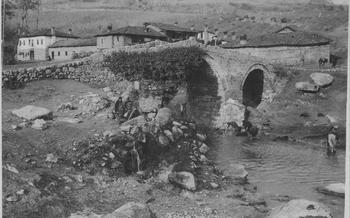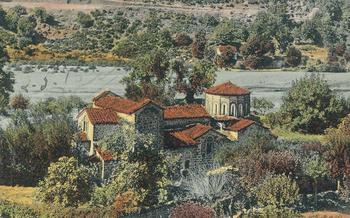
Saint Marina Church
- Saint Marina Church: A Monument of Faith and Resilience
- Pilgrimage to Saint Marina Church: A Spiritual Journey
- The Church's Architecture and Art: Masterpieces to Behold
- Unveiling the History of Saint Marina Church
- Festivals and Celebrations: Honoring Saint Marina
- Veria: A City Steeped in History and Culture
- Practical Tips for Visiting Saint Marina Church
- Exploring the Neighborhood: Hidden Gems of Veria
- Veria's Cuisine: A Culinary Journey
- Accommodation Options in Veria: A Place to Rest
- Transportation in Veria: Getting Around with Ease
- Local Customs and Traditions: Respecting Veria's Culture
- Safety Tips for Travelers: Ensuring a Smooth Visit
- Insider Tip: Discover the Hidden Courtyard
Saint Marina Church: A Monument of Faith and Resilience
In the heart of Veria, Greece, stands the awe-inspiring Saint Marina Church, a testament to the enduring power of faith and resilience. Built in the 11th century, this architectural marvel serves as a beacon of Orthodox Christianity, attracting pilgrims and visitors from far and wide. Its intricate design, adorned with beautiful frescoes and mosaics, captivates the eye, while its rich history and spiritual significance leave an indelible mark on the soul.
Saint Marina Church holds a profound place in the hearts of Orthodox believers. Dedicated to Saint Marina, a revered martyr who courageously stood up against paganism, the church embodies her unwavering faith and devotion to God. Throughout the centuries, countless pilgrims have flocked to her shrine, seeking solace, healing, and spiritual guidance. The church has become a symbol of resilience, standing firm amidst the trials and tribulations that have befallen Veria over the years.
Pilgrimage to Saint Marina Church: A Spiritual Journey
For Orthodox Christians, a pilgrimage to Saint Marina Church holds immense spiritual significance. Believers from far and wide flock to the church to seek blessings, pay homage to the saint, and find solace in her presence. Pilgrimages are often undertaken as a form of devotion, thanksgiving, or as a means of seeking intercession for personal needs.
Upon arriving at the church, pilgrims typically light candles and offer prayers at the saint's shrine. They may also participate in special services or liturgies held in her honor. It is customary for pilgrims to venerate the relics of Saint Marina, which are believed to possess miraculous powers. Some pilgrims choose to spend the night in the church, engaging in prayer and contemplation throughout the night.
The pilgrimage experience fosters a sense of deep connection with Saint Marina and the Orthodox faith. It allows pilgrims to renew their spiritual commitment, seek guidance and strength, and find comfort in the presence of the saint. The church's sacred atmosphere and the collective energy of fellow pilgrims create a profound spiritual ambiance that enhances the transformative nature of the pilgrimage journey.
The Church's Architecture and Art: Masterpieces to Behold
The Saint Marina Church stands as a testament to the architectural brilliance of the Byzantine era. Constructed in the 11th century, the church boasts a harmonious blend of Byzantine and Macedonian architectural styles. Its cruciform plan, with a central dome and four smaller domes at the corners, creates a sense of symmetry and grandeur.
Step inside the church, and you will be greeted by a symphony of colors and intricate details. The walls and ceilings are adorned with stunning frescoes and mosaics, depicting scenes from the Bible, the life of Saint Marina, and other religious figures. The vibrant hues and meticulous craftsmanship of these artworks transport visitors back to a time when faith and artistry intertwined.
The church's interior is a testament to the skill and devotion of the Byzantine artisans who created it. Every nook and cranny is adorned with intricate carvings, sculptures, and decorative elements. The marble columns, arches, and capitals showcase the mastery of Byzantine stonework. The attention to detail is simply breathtaking, inviting visitors to linger and admire the beauty of each piece.
The artwork within Saint Marina Church is not merely decorative; it serves a profound purpose. The frescoes and mosaics tell stories, convey religious messages, and inspire devotion in the hearts of the faithful. They depict scenes of martyrdom, miracles, and the life of Christ, reminding visitors of the enduring power of faith and the sacrifices made by the early Christian martyrs.
Unveiling the History of Saint Marina Church
The history of Saint Marina Church is a tapestry woven with threads of faith, resilience, and archaeological discovery. Excavations have revealed the foundations of an early Christian basilica believed to date back to the 5th century, suggesting the site's long-standing significance as a place of worship. Inscriptions and historical records provide further evidence, tracing the church's evolution over the centuries.
Oral traditions and legends passed down through generations add a layer of mystique to the church's story. One tale recounts how the church was miraculously spared during a destructive earthquake, reinforcing its reputation as a sacred and protected place. Another legend speaks of a hidden treasure buried beneath the church, waiting to be discovered by a worthy soul.
The church's architecture itself narrates the passage of time. The original basilica structure underwent modifications and expansions, incorporating elements of different architectural styles. Byzantine influences are evident in the church's dome and intricate mosaics, while later additions reflect the Ottoman and post-Ottoman periods.
These layers of history, revealed through archaeological evidence and oral traditions, paint a vivid picture of Saint Marina Church's enduring legacy. It stands as a testament to the unwavering faith of the Orthodox community in Veria, a symbol of resilience amidst historical upheavals, and a source of inspiration for pilgrims seeking spiritual solace and connection.
Festivals and Celebrations: Honoring Saint Marina
Veria comes alive each year with a vibrant celebration to honor Saint Marina, their beloved patron saint. The annual festivities, typically held in July, draw thousands of pilgrims and visitors from across the region. The city erupts in a symphony of colors, music, and religious devotion as it pays homage to its spiritual protector.
The centerpiece of the celebrations is a grand procession that winds its way through Veria's streets. Pilgrims and worshippers, adorned in traditional costumes, carry the revered icon of Saint Marina, accompanied by rhythmic chanting and the melodious tunes of traditional Greek music. The procession is a spectacle of faith and devotion, as the entire city unites in honoring their patron saint.
Other highlights of the festivities include traditional dances, music performances, and food fairs. Local dance groups showcase their skills, captivating audiences with their graceful movements and vibrant costumes. Musicians fill the air with enchanting melodies, creating a lively atmosphere that permeates the entire city.
The local community takes pride in preserving their cultural heritage through these celebrations. Traditional customs and rituals, passed down through generations, are meticulously observed, ensuring a deep connection to the city's past.
These festivals are not just religious events but also a testament to Veria's rich cultural identity. They provide a glimpse into the heart and soul of the city, showcasing its deep-rooted traditions and the enduring legacy of Saint Marina, who continues to watch over her beloved Veria.
Veria: A City Steeped in History and Culture
Veria, nestled in the heart of northern Greece, is a city that exudes a rich tapestry of history and culture. Its roots can be traced back to ancient times, when it was known as Beroea, a significant city in the Macedonian kingdom. Throughout the centuries, Veria has witnessed the rise and fall of empires, leaving behind a legacy of architectural wonders, historical landmarks, and cultural traditions.
One of Veria's most notable landmarks is the ancient Agora, the city's central marketplace. Here, visitors can step back in time and imagine the bustling atmosphere of traders and merchants, the lively exchanges of goods and ideas. The Agora is surrounded by well-preserved stoas, colonnaded walkways that once sheltered shops and workshops.
Another must-see attraction is the Veria Archaeological Museum, which houses an impressive collection of artifacts from the city's past. From ancient sculptures and pottery to intricate mosaics and jewelry, the museum offers a glimpse into the artistry and craftsmanship of Veria's ancestors.
Veria has also played a significant role in the history of Greek art, literature, and philosophy. It was the birthplace of the renowned philosopher Sopater, who was a student of Plato and a tutor to Alexander the Great. The city's contributions to Greek culture continue to be celebrated through various festivals and events throughout the year.
As a crossroads of civilizations, Veria has absorbed influences from different cultures and periods, creating a unique blend of architectural styles and traditions. From Byzantine churches to Ottoman mosques and neoclassical mansions, the city's streetscapes offer a visual feast for visitors.
With its rich history, cultural heritage, and warm hospitality, Veria invites travelers to immerse themselves in its timeless charm and discover the secrets of a city that has stood the test of time.
Practical Tips for Visiting Saint Marina Church
Location and Accessibility:
Saint Marina Church is conveniently located in the heart of Veria, making it easily accessible to visitors. The address is [Insert Address]. To reach the church, you can take a leisurely walk from the city center, which takes approximately 15 minutes. Alternatively, you can take a taxi or rent a bicycle for a more scenic journey. For those with limited mobility, the church is wheelchair accessible, ensuring a comfortable visit for all.
Dress Code and Etiquette:
When entering Saint Marina Church, it is important to observe the appropriate dress code and etiquette. While there is no strict dress code, dressing modestly and respectfully is customary. For women, covering the shoulders and knees is recommended. Photography is allowed inside the church, but it is essential to be mindful of the ongoing religious services and avoid disturbing the worshippers.
Suggested Times to Visit:
To experience Saint Marina Church in its tranquil state, it is advisable to visit during the early morning hours or late afternoon, when the crowds are fewer. This will allow you to fully immerse yourself in the church's serene atmosphere and appreciate its beauty without distractions.
Additional Tips:
Before your visit, it is recommended to do some research about the history and significance of Saint Marina and the church. This will enhance your understanding and appreciation of the site. Additionally, consider joining a guided tour to gain deeper insights into the church's architecture, artwork, and religious significance.
Exploring the Neighborhood: Hidden Gems of Veria
Beyond the walls of Saint Marina Church, the surrounding neighborhood offers a wealth of hidden gems waiting to be discovered. Narrow cobblestone streets and alleys wind their way through the area, lined with traditional houses and shops that have stood the test of time. Visitors can step into these charming establishments to find unique souvenirs, handcrafted goods, and delicious local delicacies.
Strolling through the neighborhood, one can admire the beautiful architecture that showcases Veria's rich history. Historic mansions, churches, and public buildings stand side by side, each telling a story of the city's past. Small cafes and tavernas dot the streets, inviting visitors to savor traditional Greek cuisine and soak in the vibrant atmosphere.
For those seeking cultural experiences, the neighborhood offers several historical and cultural landmarks within easy reach. The Archaeological Museum of Veria houses a collection of artifacts that provide a glimpse into the city's ancient past. The Folklore Museum showcases traditional costumes, tools, and household items, offering insights into the lives of Veria's people throughout the centuries.
Exploring the neighborhood surrounding Saint Marina Church is a journey into the heart of Veria's culture and history. Whether you seek unique shopping experiences, authentic culinary delights, or historical discoveries, this vibrant area offers something for every traveler.
Veria's Cuisine: A Culinary Journey
Veria's culinary heritage is a testament to its rich history and cultural influences. The city's cuisine blends traditional Greek flavors with unique local ingredients, creating a diverse and delectable culinary scene.
One must-try dish is "fasolada," a hearty white bean soup flavored with herbs and spices. For a taste of local delicacies, try "tourlou," a vegetable stew with zucchini, eggplant, and tomatoes, or "giouvarlakia," meatballs in a flavorful egg-lemon sauce.
To satisfy your sweet tooth, indulge in "trigona Panagias," crispy pastries filled with a sweet walnut and honey filling. And don't miss the chance to sample Veria's famous "loukoumades," bite-sized doughnuts drizzled with honey and cinnamon.
When it comes to dining, Veria offers a range of options to suit every taste and budget. From traditional tavernas serving up classic Greek dishes to modern restaurants with a creative twist, there's something for every palate.
For an authentic experience, head to one of the many family-run tavernas in the old town. Here, you'll find warm hospitality and delicious home-cooked meals prepared with fresh, seasonal ingredients.
Whether you're a foodie or simply looking for a taste of local culture, Veria's culinary delights are sure to tantalize your taste buds and leave you wanting more.
Accommodation Options in Veria: A Place to Rest
Veria offers a range of accommodation options to suit every taste and budget. Whether you're looking for a luxurious hotel, a cozy guesthouse, or a budget-friendly hostel, you'll find plenty of choices within easy reach of Saint Marina Church and other attractions.
Many hotels and guesthouses in Veria are conveniently located within walking distance of the church, allowing visitors to explore the city's historic center on foot. These accommodations often offer amenities such as comfortable rooms, private bathrooms, air conditioning, and free Wi-Fi.
For those on a tighter budget, there are several hostels and budget hotels available. These properties typically offer basic but clean and comfortable rooms at a more affordable price. Some hostels also have shared kitchens and common areas, where guests can socialize and share travel experiences.
When choosing your accommodation in Veria, it's important to consider your budget, travel style, and preferences. If you're looking for a luxurious stay with all the amenities, there are several upscale hotels to choose from. If you prefer a more intimate and local experience, consider staying in a charming guesthouse or bed and breakfast. And if you're on a tight budget, there are plenty of hostels and budget hotels that offer good value for money.
No matter where you choose to stay, you'll find that Veria's accommodation options are welcoming and comfortable, providing a perfect base for exploring this historic and vibrant city.
Transportation in Veria: Getting Around with Ease
Navigating Veria is a breeze, thanks to its efficient public transportation system. Buses ply the city's streets, connecting major landmarks and neighborhoods. For those who prefer a more independent mode of exploration, rental car services are readily available. Exploring Veria by car offers the freedom to venture beyond the city center and discover the surrounding countryside.
When navigating Veria's streets, be mindful of the local driving customs and traffic conditions. While the city's roads are generally well-maintained, narrow streets and occasional congestion can be encountered. Patience and defensive driving are key to ensuring a smooth and safe journey.
For those arriving by air, Veria is conveniently served by Thessaloniki International Airport (SKG), located approximately 70 kilometers away. From the airport, travelers can take a bus or taxi to reach Veria. The journey by road takes about an hour.
Whether you choose to explore Veria on foot, by public transport, or by car, the city's compact size and well-connected infrastructure make getting around a hassle-free experience. Embrace the opportunity to immerse yourself in Veria's vibrant culture and rich history as you navigate its streets and discover its hidden gems.
Local Customs and Traditions: Respecting Veria's Culture
Veria, like many Greek destinations, has a rich cultural heritage that shapes its customs and traditions. As travelers, it's important to be respectful and mindful of these customs to ensure a positive experience for both visitors and locals. Here are a few points to consider:
-
Greetings: When meeting someone for the first time, it's customary to greet them with a handshake or a kiss on both cheeks for close friends and family. A simple "kalimera" (good morning) or "kalispera" (good evening) is the appropriate greeting.
-
Social Etiquette: Greeks are generally warm and welcoming, and they value politeness and respect. When interacting with locals, it's important to be polite and avoid raising your voice or speaking aggressively.
-
Religious Sensitivity: Greece is a predominantly Orthodox Christian country, and religious traditions are deeply ingrained in the culture. Respect local religious customs, such as dressing modestly when visiting churches or monasteries.
-
Respecting Personal Space: Greeks tend to have a closer personal space than some other cultures. Be mindful of this when standing in line or having conversations to avoid making anyone uncomfortable.
-
Tipping: Tipping is customary in Greece, especially in restaurants and cafes. A tip of 10-15% is generally considered appropriate.
By being respectful of local customs and traditions, travelers can help preserve the unique cultural heritage of Veria and ensure a harmonious and enjoyable experience for all.
Safety Tips for Travelers: Ensuring a Smooth Visit
Veria is generally a safe city for travelers, but it's always wise to take precautions to ensure a smooth and enjoyable visit. Here are some safety tips to keep in mind:
-
Be aware of your surroundings: Pay attention to your surroundings and be cautious of any suspicious activity or individuals. Avoid walking alone at night, especially in poorly lit areas.
-
Protect your belongings: Keep your valuables safe by using a money belt or other security measures. Avoid carrying large amounts of cash, and be careful when using ATMs or exchanging currency.
-
Be wary of scams: Be aware of common scams, such as fake tour guides, overpriced goods, or unsolicited services. Always ask for official identification and be cautious of anyone who approaches you aggressively.
-
Respect local customs: Be respectful of local customs and traditions, especially when visiting religious or cultural sites. Dress appropriately, avoid taking photographs of people without their permission, and be mindful of noise levels.
-
Emergency contact numbers: Keep emergency contact numbers handy, including the local police station and the nearest hospital. In case of an emergency, dial 112 or 100 for the police, and 166 for the ambulance.
Insider Tip: Discover the Hidden Courtyard
In the heart of the Saint Marina Church complex, nestled away from the bustling crowds, lies a secret courtyard that offers a tranquil retreat for pilgrims and visitors alike. This hidden gem is an oasis of peace and serenity, where one can find respite from the vibrant energy of the city.
Stepping into the courtyard is like entering a different world. The air is still and calm, and the only sounds that can be heard are the gentle chirping of birds and the rustling of leaves in the breeze. The courtyard is surrounded by beautiful gardens, with colorful flowers blooming in abundance. The scent of jasmine and lavender fills the air, creating a fragrant and inviting atmosphere.
At the center of the courtyard stands a majestic fountain, its gentle waters cascading into a serene pool. The fountain is adorned with intricate carvings and sculptures, depicting scenes from the life of Saint Marina and other biblical stories. The water's gentle murmur adds to the peaceful ambiance of the courtyard, inviting visitors to sit down and reflect on the spiritual significance of this sacred space.
The hidden courtyard is a place where pilgrims can come to pray, meditate, and connect with their faith. It is also a place where visitors can escape the hustle and bustle of city life and find a moment of peace and tranquility. Whether you are seeking spiritual enlightenment or simply a quiet place to relax and unwind, the hidden courtyard of Saint Marina Church is a must-visit destination in Veria.
